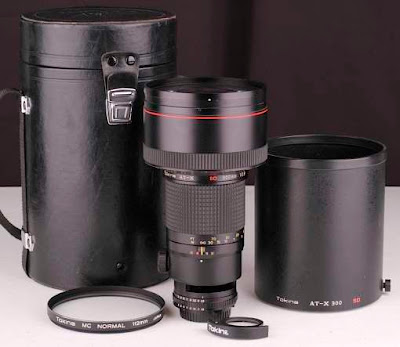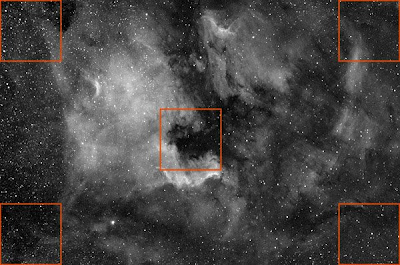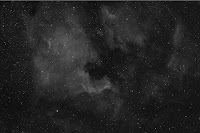COPYRIGHT, PLEASE NOTE
All the material on this website is copyrighted to J-P Metsavainio, if not otherwise stated. Any content on this website may not be reproduced without the author’s permission.
Have a visit in my portfolio
PORTFOLIO:https://astroanarchy.zenfolio.com/
Sunday, September 14, 2008
New Lens for astro imaging


 Tokina AT-X 300 f2.8 is a big and heavy lens.
Tokina AT-X 300 f2.8 is a big and heavy lens.
Diameter of the main lens is 112mm.
Optical quality is very good. At f2.8 stars are absolute pinpoints to very corner of the
imaging area of my APS size camera.
STAR TEST IMAGES, LENS FULL OPEN @ f2.8:
Here is five images from cornes and the center of the image.
Image is just stacked (5 x 900s) and stretched, no other image processing methods are used.



Some brighter stars may have some distortion, but it's cauced by guiding and polar alignment errors.
-
-
 This is a single 900s H-alpha filtered, flat and bias calibrated frame.
This is a single 900s H-alpha filtered, flat and bias calibrated frame.Red pixels only, hence 1/4 size from original frame.
Mildly stretched under CCDStack software due the 8bit format, no other prcessing.
Labels:
equipments,
research and development
Tuesday, July 29, 2008
Comparison of Flame Nebula, with and without stars

This is an example of star removal technique.
Two images of the same target is presented here with and
without stars.
In starless image, the nebulosity is much more visible and some
forms can be seen only in this image.
This can be usefull technique to reweal very faint nebulosity hidden
in overwhelming starfields.
Click for large image.
Labels:
research and development
Thursday, July 17, 2008
Sh2-240 Reprocessed

This was really hard to catch and process.
Somehow better now, I think.
The Sh2-240 (Simeis 147) is a very faint supernova remaint in Taurus.
The image is in false color to show hydrogen alpha emission.Original BW H-alpha image at the bottom
-
IMAGING DETAILS
-Optics:
Canon FD 200mm f2.8 lens with full aperature
- Camera:
QHY8
- Platform and guiding:
LX200 GPS 12" with QHY5 guider and PHD-guiding
- Exposures:
10 x 3600s + 4 x 2700s + 3 x 900s H-alpha + Flats and Bias frames, no darks
exposure time so far 13h 45min.
- Filter:
Baader 7nm H-alp + IDAS LP for RGB

H-alpha
Wednesday, July 16, 2008
Veil Nebula, Western part (reprocessed)

Veil Nebula is a supernova remnant with large angular diameter.
Located about 1400 light years away in the constellation Cygnus.
This is a reprocessed version from Autumn 2007.
ED80 + QHY8, guiding LX200+QHY5, UHC-filter 4h+flats+bias.
-
Eastern part of the Nebula can be seen here:
Tuesday, July 15, 2008
Who need Stars?
This is a just a test. Large gas clouds are located usually in dense star fields and bright
stars are dominating the image, even in narrowband images.
Sometimes it's difficult to see actual target from stars.
In this test I removed stars from images by using several PS filters, like Minimum, Dust & Scratches and some other star reducing methods.
-
I think, in this way the actual targets and they forms are more visible.
Klick thumbnail for the large image.
 "Bubble Nebula"
"Bubble Nebula"
 "Elephants Trunk"
"Elephants Trunk"
 The core of the "Heart Nebula"
The core of the "Heart Nebula"
 "Andromeda Galaxy"
"Andromeda Galaxy"
 IC1936
IC1936
 "North America Nebula"
"North America Nebula"
 "Flaming Star Nebula"
"Flaming Star Nebula"
 Part of the IC1848 "Soul Nebula"
Part of the IC1848 "Soul Nebula"
 Sh2-240
Sh2-240
 "California Nebula"
"California Nebula"
 "Rose Nebula"
"Rose Nebula"
 "Hart and Soul"
"Hart and Soul"
 Wwil Nebula Western part
Wwil Nebula Western part
 Weil Nebula Eastern part
Weil Nebula Eastern part
Labels:
research and development
Friday, July 4, 2008
More repocessed material
from galaxy core.
Details in original post.
 IC1848 (Part of the Soul nebula) in H-alpha light + RGB data trough UHC-s filter.
IC1848 (Part of the Soul nebula) in H-alpha light + RGB data trough UHC-s filter.
Details in original post.

M106, details in original post.
Tuesday, July 1, 2008
California Nebula Reprocessed
 This version is combined from two images of the same target.Images are taken with different optical configurations. First was taken with SW 80ED refractor and second with Canon EF 200mm f2.8 camera lens.
CCDstack software was used to combine those two images and here is the result.
This version is combined from two images of the same target.Images are taken with different optical configurations. First was taken with SW 80ED refractor and second with Canon EF 200mm f2.8 camera lens.
CCDstack software was used to combine those two images and here is the result.
Monday, June 30, 2008
Reprocessed material from winter 2007-08
Here in northern Finland we have now a mandatory pause for astro imaging doe the high latitude.
Now is good time to reorganize image archives and improve processing skils.
Few new images was found from my HD, like material for M45 image.
I just place images here with they name. Imaging details can be found from original posts.
All the images are taken with QHY8 camera trough various optical conficurations.
Note! Some fo the images are in high resolution.
Klick for the large image.
 M45
M45
 Horse Head nebula
Horse Head nebula
 M31
M31
 North America Nebula
North America Nebula
Tuesday, April 22, 2008
M106, update

Now it's over here, nights are not astronomically dark anymore.
-
I managed to shoot 18.04. three more hours for M106.
The outer halo is now somehow more visble but massive light pollution, in my
location, eats out lots of it, IDAS LP filter helpped though..
_
I used longer subs, 1200s, for this secon tryout.
9 x 1200s = 3h
-
There is older subs, 8x900s from 17.04, combined to this new image,
so there is 5h total exposure time used.
-
Same setup, than in previous post.
-
I'm very pleased to functionality of SXV-AO active optics unit.
Becouset of AO, many details can be seen in the core of the M106 galaxy.
Processing was difficult doe the gradients coused by LP.
There is some deconvolution and wavelets used in processing
to bring out details more cleary.
Labels:
galaxy images
Thursday, April 17, 2008
M106, last project of the season.

Nights are getting shorter and shorter up here north.
Lenght of the day is now 15h 30min. Astronomical darkness
last from 23:38 to 02:57 tonight.
One week from now here is no astronomical darkness untill autumn.
-
This is the last target for this season. I managed to capture two hours
of data last night. I'll try shoot more data tonight.
M106 (Object number 106 in Messier catalog)
Allso known as NGC 4258.
-
M106 is a spiral galaxy located in constellation Canes Venatici.
Distance is about 25 million light-years from my home.
-
IMAGING DETAILS
-
Optics: Meade LX200 GPS 12" @ f6.3
-
Camera: QHY8
-
guiding: SXV-AO, active optics unit and LodeStar guider
-
Exposures: 8 x 900s+ Flats and Bias frames, no darks total exposure time 2h.
-
Filter: IDAS LP
Monday, April 14, 2008
M13 as a Stereo Pair

-
 Cross vision stereo pair
Cross vision stereo pair
This is a second version of M13 as a stereo pair image.
This time I used about same method as in Sh2-240 image posted before.
Image is better resolved to the core and stars are more uniformly spreaded
in space.
Image information in original M13 post.
Viewing instructions, look for right side menu.
-
 Cross vision stereo pair
Cross vision stereo pair
Labels:
stereo images
Wednesday, April 9, 2008
The Learning Curve

The term learning curve refers to a relationship between the duration of learning or experience and the resulting progress. Initially introduced in cognitive psychology, over time the term has acquired a broader interpretation, and expressions such as "experience curve", "improvement curve", "cost improvement curve", "progress curve"/"progress function", "startup curve", and "effeciency curve" are often used interchangeably, depending on the context. Some of these terms may also have other meanings.
-
(Above text is borrowed from Wikipedia)
_
This image serie is example of my leraning curve with the Galaxy M51.
-
All the images are taken with same optics, LX200 GPS 12".
-
The oldest one, 2005, is taken with Canon 300D, in Alt/Az
Image from 2007 is taken with QHY8.
Latest image is taken with QHY8 and SXV-AO, active optics.
-
The impact of imaging conficuration is not as big as
impact of the improved processing skills.
Tuesday, April 8, 2008
M13-reprocessed

This image of M13 is from night of 07.03.2008.
I added some wavelets function to it under RegiStack4 software.
The difference is not huge, but dimmer outer stars are now better resolved.
Original M13 is here:
http://tinyurl.com/6cqfne
Imaging data can be found here:
Sunday, April 6, 2008
Stereo Technique, general notes
NOTES ABOUT IMAGE SIZE.
_
When you process the image, it should be at original resolution or moderately
scaled down.
_
After all the processing is done, image has to be scaled down for viewing.
The rule of thumb is, that distance between two images should not be large than distance between eyes.
Large the picture is, the more difficult it is to form a stereo image.
_
With the Cross Vision method, the image scale can be somehow large.
-
GENERAL NOTES OF THE METHOD USED
_
Technique precented here is different, than one I have used for my images.
The reason is, that there is now no need for professional 3D-software.
It has some limitations, but overall the actual results are more or less similar.
-
Many astro Enthusiastics have done about similar things before with stereo images.
The main difference from this method is, that methods used usually are not very suitable for complex forms, like nebulas.
They are mainly based on simple methods, where objects are moved linear way to
create pseudo 3D-effect.
-
If based on real data from objects, those images can be pretty accurate presentaions of the real phenomens.
The reason I'm interested this kind of thigs is, that this way I can see the "real" nature of the object with my own eyes, and maybe I'm able to reveal some of the hidden beauty of the targets as well
-
Labels:
research and development
Subscribe to:
Posts (Atom)




























